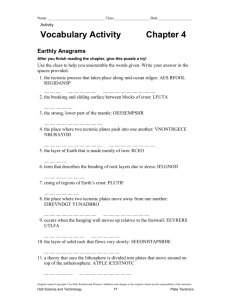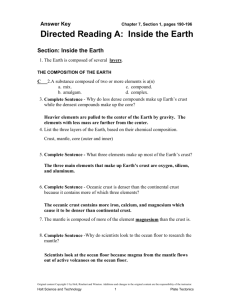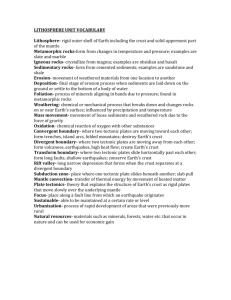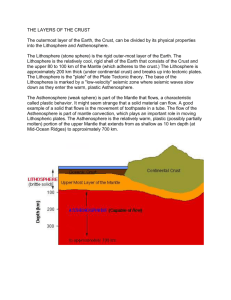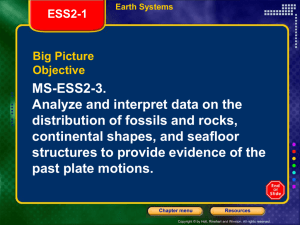tectonic mantle
advertisement
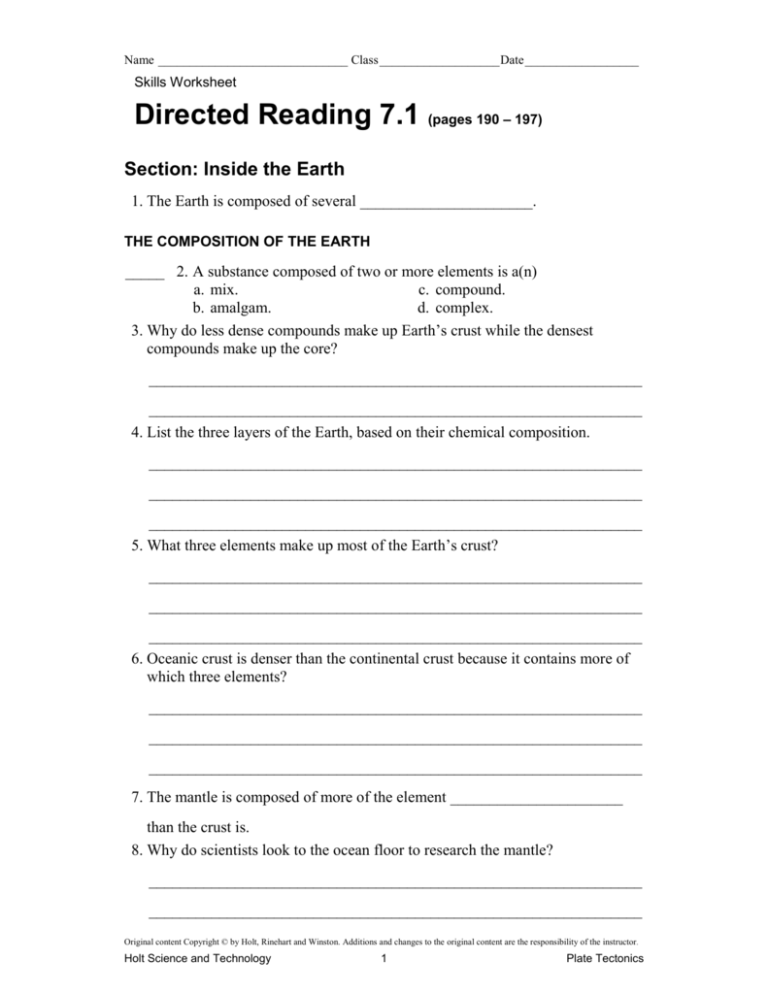
Name ______________________________ Class ___________________ Date __________________ Skills Worksheet Directed Reading 7.1 (pages 190 – 197) Section: Inside the Earth 1. The Earth is composed of several ______________________. THE COMPOSITION OF THE EARTH _____ 2. A substance composed of two or more elements is a(n) a. mix. c. compound. b. amalgam. d. complex. 3. Why do less dense compounds make up Earth’s crust while the densest compounds make up the core? _______________________________________________________________ _______________________________________________________________ 4. List the three layers of the Earth, based on their chemical composition. _______________________________________________________________ _______________________________________________________________ _______________________________________________________________ 5. What three elements make up most of the Earth’s crust? _______________________________________________________________ _______________________________________________________________ _______________________________________________________________ 6. Oceanic crust is denser than the continental crust because it contains more of which three elements? _______________________________________________________________ _______________________________________________________________ _______________________________________________________________ 7. The mantle is composed of more of the element ______________________ than the crust is. 8. Why do scientists look to the ocean floor to research the mantle? _______________________________________________________________ _______________________________________________________________ Original content Copyright © by Holt, Rinehart and Winston. Additions and changes to the original content are the responsibility of the instructor. Holt Science and Technology 1 Plate Tectonics Name ______________________________ Class ___________________ Date __________________ Directed Reading A continued 9. The mantle has less aluminum and less ______________________ than the crust does. 10. What element makes up most of the Earth’s core? _______________________________________________________________ _______________________________________________________________ 11. How much of the Earth’s mass is made up by the core? _______________________________________________________________ _______________________________________________________________ THE PHYSICAL STRUCTURE OF THE EARTH Match the correct description with the correct term. Write the letter in the space provided. _____ 12. the outermost, rigid layer of the Earth _____ 13. a layer of slowly flowing rock in the mantle _____ 14. the liquid layer of the core a. b. c. d. e. asthenosphere lithosphere mesosphere outer core inner core _____ 15. the solid layer of the core _____ 16. the strong, lower part of the mantle TECTONIC PLATES _____ 17. Large pieces of the lithosphere that move around on the asthenosphere are called a. mantle pieces. b. crust pieces. c. tectonic plates. d. puzzle pieces. 18. Why are tectonic plates like the pieces of a jigsaw puzzle? _______________________________________________________________ _______________________________________________________________ 19. What are the two kinds of crust that a tectonic plate may contain? _______________________________________________________________ _______________________________________________________________ Original content Copyright © by Holt, Rinehart and Winston. Additions and changes to the original content are the responsibility of the instructor. Holt Science and Technology 2 Plate Tectonics Name ______________________________ Class ___________________ Date __________________ Directed Reading A continued 20. List three ways in which tectonic plates floating on the asthenosphere are similar to ice cubes filling a punch bowl. _______________________________________________________________ _______________________________________________________________ _______________________________________________________________ MAPPING THE EARTH’S INTERIOR _____ 21. What do scientists use to study Earth’s interior? a. sea-floor spreading rates b. magnetic reversals c. global positioning system d. seismic waves _____ 22. What are seismic waves? a. movements in the outer core b. pictures of the Earth’s interior c. vibrations from an earthquake d. vibrations from a seismograph 23. Will a seismic wave traveling through a solid go faster or slower than a seismic wave traveling through liquid? Explain your answer. _______________________________________________________________ _______________________________________________________________ _______________________________________________________________ Original content Copyright © by Holt, Rinehart and Winston. Additions and changes to the original content are the responsibility of the instructor. Holt Science and Technology 3 Plate Tectonics
